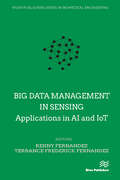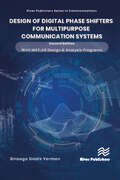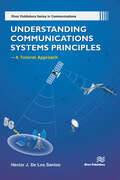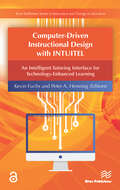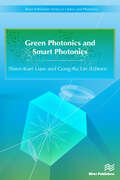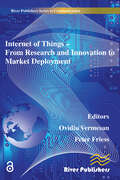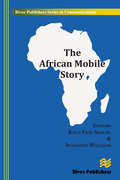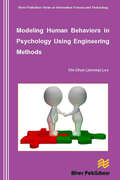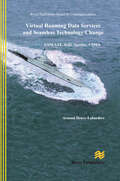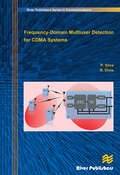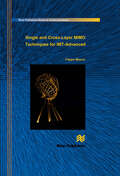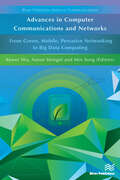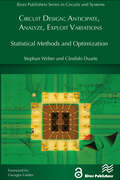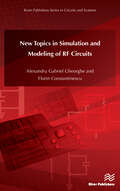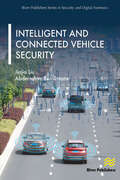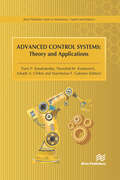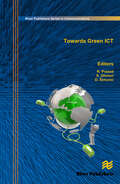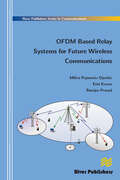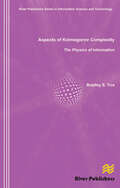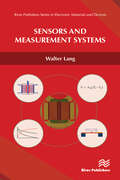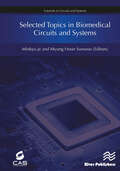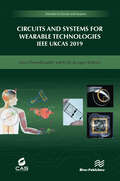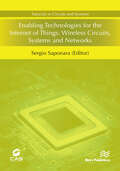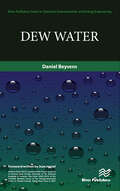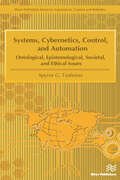- Table View
- List View
Big data management in Sensing: Applications in AI and IoT
by Renny Fernandez Terrance Frederick FernandezThe book is centrally focused on human computer Interaction and how sensors within small and wide groups of Nano-robots employ Deep Learning for applications in industry. It covers a wide array of topics that are useful for researchers and students to gain knowledge about AI and sensors in nanobots. Furthermore, the book explores Deep Learning approaches to enhance the accuracy of AI systems applied in medical robotics for surgical techniques. Secondly, we plan to explore bio-nano-robotics, which is a field in nano-robotics, that deals with automatic intelligence handling, self-assembly and replication, information processing and programmability.
Design of Digital Phase Shifters for Multipurpose Communication Systems
by Binboga Siddik YarmanThis book aims to cover a new emerging need in designing digital phase shifter for modern communication systems. With the advancement of new generation mobile communication systems, directed beams of antenna arrays save a substantial amount of power as well as improve the communication quality. In this regard, beam-forming circuits, such as digital phase shifters (DPS) constitute essential parts of the antenna array systems. Therefore, this book is devoted to the design of digital phase shifters for various communications systems. Nowadays, phase array systems demand compact phase shifters suitable for chip implementation with wide phase-range and broad frequency band. Each chapter of this book is organized as stand-alone in such a way that the reader requires no specific background acquired from the other chapters. For each phase shifter topology introduced in this book, the reader is furnished with explicit design equations to construct the circuit under consideration. Furthermore, design equations are programmed using MATLAB to assess the electrical performance of the phase shifters with ideal and lossy components. MATLAB design programs are given at the and of each chapter as appendices and provided as soft copy on the web page of the book. In chapters 12 and 14, MMIC layouts for the lattice and T-section based DPS are provided for the readers. It is hoped that an interested reader can immediately identifies the “optimum phase shifter topology” for the need under consideration with its estimated electric performance.
Understanding Communications Systems Principles—A Tutorial Approach
by Héctor J. SantosWireless communications and sensing systems are nowadays ubiquitous; cell phones and automotive radars typifying two of the most familiar examples. This book introduces the field by addressing its fundamental principles, proceeding from its very beginnings, up to today's emerging technologies related to the fifth-generation wireless systems (5G), Multi-Input Multiple Output (MIMO) connectivity, and Aerospace/Electronic Warfare Radar. The tone is tutorial. Problems are included at the end of each chapter to facilitate the understanding and assimilation of the material to electrical engineering undergraduate/graduate students and beginning and non-specialist professionals. Free temporary access to Keysight's SystemVue system simulation is provided to further enhance reader learning through hands-on tutorial exercises.Chapter 1 introduces wireless communications and sensing and in particular how curiosity-driven scientific research led to the foundation of the field. Chapter 2 presents a brief introduction to the building blocks that make up wireless systems. Chapter 3 focuses on developing an understanding of the performance parameters that characterize a wireless system. Chapter 4 deals with circuit topologies for modulation and detection. In chapter 5 we cover the fundamental transmitter and receiver systems architectures that enable the transmission of information at precise frequencies and their reception from among a rather large multitude of other signals present in space. Chapter 6 introduces 5G, its motivation, and its development and adoption challenges for providing unprecedented levels of highest speed wireless connectivity. Chapter 7 takes on the topic of MIMO, its justification and its various architectures. Chapter 8 addresses the topic of aerospace/electronic warfare radar and finally Chapter 9 presents three Tutorials utilizing the SystemVue simulation tool.
Computer-Driven Instructional Design with INTUITEL: An Intelligent Tutoring Interface For Technology-enhanced Learning (River Publishers Series In Innovation And Change In Education Ser.)
by Kevin Fuchs Peter A. HenningINTUITEL is a research project that was co-financed by the European Commission with the aim to advance state-of-the-art e-learning systems via addition of guidance and feedback for learners. Through a combination of pedagogical knowledge, measured learning progress and a broad range of environmental and background data, INTUITEL systems will provide guidance towards an optimal learning pathway. This allows INTUITEL-enabled learning management systems to offer learners automated, personalised learning support so far only provided by human tutors INTUITEL is - in the first place - a design pattern for the creation of adaptive e-learning systems. It focuses on the reusability of existing learning material and especially the annotation with semantic meta data. INTUITEL introduces a novel approach that describes learning material as well as didactic and pedagogical meta knowledge by the use of ontologies. Learning recommendations are inferred from these ontologies during runtime. This way INTUITEL solves a common problem in the field of adaptive systems: it is not restricted to a certain field. Any content from any domain can be annotated. The INTUITEL research team also developed a prototype system. Both the theoretical foundations and how to implement your own INTUITEL system are discussed in this book.
Green Photonics and Smart Photonics
by Shien-Kuei Liaw Gong-Ru LinIn recent years, many efforts have been devoted in the study, development and application of Green Photonics and Smart Photonics. This book presents recent advances, both theoretical and applications, reflecting the cutting-edge technologies and research achievements within these research fields.Green Photonics intend to develop photonics technologies that can conserve energy, reduce pollution and create renewable energy. Light emitting diodes (LEDs) and solar cells with the characteristics of sustainable and low energy consumption are addressed in this book. The term of Smart Photonics reflect intelligence of optical and optoelectronic components with high sensitivity, fast response time and/or compact size. The book explores various aspects ofsmart photonics including fiber sensors, optoelectronic devices and waveguide devices. The chapters in this edited book are written by researchers who presented quality papers at the 2015 International Symposium of Next-Generation Electronics (ISNE 2015), which was held in Taipei, Taiwan. The ISNE 2015 provided a common forum in the areas of opto-electron devices, photonics, integrated circuits, and microelectronic systems and technologies. The technical program consisted of 5 plenary talks, 23 invited talks and more than 250 contributed oral and poster presentations. After a rigorous review process, the ISNE 2015 technical program committee has selected 10 outstanding presentations and invited the authors to prepare extended chapters for inclusion in this book. Of the 10 chapters, five focus on the subject of green photonics, and the others cover smart photonics.
Internet of Things Applications - From Research and Innovation to Market Deployment
by Ovidiu Vermesan Peter FriessThe book aims to provide a broad overview of various topics of Internet of Things from the research, innovation and development priorities to enabling technologies, nanoelectronics, cyber physical systems, architecture, interoperability and industrial applications. It is intended to be a standalone book in a series that covers the Internet of Things activities of the IERC – Internet of Things European Research Cluster from technology to international cooperation and the global "state of play".The book builds on the ideas put forward by the European research Cluster on the Internet of Things Strategic Research Agenda and presents global views and state of the art results on the challenges facing the research, development and deployment of IoT at the global level. Internet of Things is creating a revolutionary new paradigm, with opportunities in every industry from Health Care, Pharmaceuticals, Food and Beverage, Agriculture, Computer, Electronics Telecommunications, Automotive, Aeronautics, Transportation Energy and Retail to apply the massive potential of the IoT to achieving real-world solutions. The beneficiaries will include as well semiconductor companies, device and product companies, infrastructure software companies, application software companies, consulting companies, telecommunication and cloud service providers. IoT will create new revenues annually for these stakeholders, and potentially create substantial market share shakeups due to increased technology competition. The IoT will fuel technology innovation by creating the means for machines to communicate many different types of information with one another while contributing in the increased value of information created by the number of interconnections among things and the transformation of the processed information into knowledge shared into the Internet of Everything. The success of IoT depends strongly on enabling technology development, market acceptance and standardization, which provides interoperability, compatibility, reliability, and effective operations on a global scale. The connected devices are part of ecosystems connecting people, processes, data, and things which are communicating in the cloud using the increased storage and computing power and pushing for standardization of communication and metadata. In this context security, privacy, safety, trust have to be address by the product manufacturers through the life cycle of their products from design to the support processes. The IoT developments address the whole IoT spectrum - from devices at the edge to cloud and datacentres on the backend and everything in between, through ecosystems are created by industry, research and application stakeholders that enable real-world use cases to accelerate the Internet of Things and establish open interoperability standards and common architectures for IoT solutions. Enabling technologies such as nanoelectronics, sensors/actuators, cyber-physical systems, intelligent device management, smart gateways, telematics, smart network infrastructure, cloud computing and software technologies will create new products, new services, new interfaces by creating smart environments and smart spaces with applications ranging from Smart Cities, smart transport, buildings, energy, grid, to smart health and life. Technical topics discussed in the book include: • Introduction• Internet of Things Strategic Research and Innovation Agenda• Internet of Things in the industrial context: Time for deployment.• Integration of heterogeneous smart objects, applications and services• Evolution from device to semantic and business interoperability• Software define and virtualization of network resources• Innovation through interoperability and standardisation when everything is connected anytime at anyplace• Dynamic context-aware scalable and trust-based IoT Security, Privacy framework• Federated Cloud service management and the Internet of Things• Internet of Things Applications
The African Mobile Story
by Knud Erik Skouby Idongesit WilliamsAfrica and especially Sub-Saharan Africa has during the past decade witnessed one of the fastest growing markets in mobile communication. This growth is recognized to have played a pivotal role in Africa’s socio-economic development. It has had a huge impact on residential living patterns; on business networks and models; and on government services and income sources. The mobile industry has contributed more to economic growth than in any other comparable region globally introducing innovative, broadly used applications. Technical topics discussed in the book include:• Mobile Development in Sub-Saharan Africa;• Telecom Liberalization in Africa;• Role of Mobile in Socio-economic Development;• Mobile Applications in specific sectors;• Security in African Mobile;• Role of Prepaid in Africa
Modeling Human Behaviors in Psychology Using Engineering Methods
by Chi-Chun LeeThe main purpose of the work is to showcase the interdisciplinary engineering approaches in modeling and understanding human behaviors during interpersonal interactions those that could be typical, distressed, or atypical. The ability to measure human behaviors quantitatively has been a core component and a major research direction in both fields of engineering and psychology – though often with distinct approaches designed for different targeted applications. Engineering methods often strive to achieve high predictive accuracies using behavioral informatics techniques; these techniques employ a combination of behavior measures derived using automated signal based descriptors, and of statistical frameworks modeled using machine learning techniques. These approaches are often distinct from the observational approaches the gold standard for the past three decades in the study of psychology, even in clinical settings. The observational approaches are largely based on human subjective judgments.
Virtual Roaming Data Services and Seamless Technology Change: GSM, LTE, WiFi, Satellite, CDMA
by Arnaud Henry-LabordèreThe subject is “Virtual Roaming for data services” and “Seamless Technology change” also called “Number Continuity”.“Virtual Roaming for voice and SMS” was covered in one of the author's previous book. “Virtual Roaming” means that it allows a subscriber to visit a network which his home network does not have an agreement with. The “Seamless Technology change” allows a user to keep all his services including reception of calls and SMS sent to his usual number when he switches his GSM to a Satellite phone or to WiFi. The implementation of Seamless Technology change uses the SS7 Roaming Hub and GTP Hubs technology explained in the first part of the book. The book also contains chapters explaining in detail the steering and anti-steering of roaming, LTE Serving Mobile Location Centers, and Advanced Policy and Charging implementations in LTE and 3G. This is to be used as an easy reference book. All the relevant references to the standards are included chapter by chapter. This is the first book on the two main subjects of Virtual Data Roaming and Seamless Technology change. Keywords:Virtual Roaming, Number Continuity, Seamless technology change, Policy Charging and Control, LTE LBS, Steering of Roaming, GTP Hub, MMS Hub,RADIUS Hub, DIAMETER Hub
Frequency-Domain Multiuser Detection for CDMA Systems
by Paulo Silva Rui DinisFuture broadband wireless communication systems are expected to be able to offer new and powerful services enabling fast transmission rates of several tens of Mbit/s. This is an ambitious challenge especially for mobile communication systems since these systems should be able to cope with severely time dispersive channels, associated to the signal multipath propagation. Moreover, these systems should have high spectral and power efficiencies, as well as high capacity and flexibility. Spread spectrum techniques, particularly coded division multiple access (CDMA) techniques allow high capacity and flexibility, continuous transmission requiring low-peak power requirements for the amplifiers, as well as some robustness against fading and time-dispersion effects associated with the multipath propagation. When employed in prefix assisted (PA) block transmission schemes combined with frequency-domain receiver implementations they become especially interesting for broadband wireless systems. In Frequency-Domain Multiuser Detection for CDMA Systems the use of PA block transmission is considered in the context of both DS (Direct Sequence) and MC (Multicarrier) CDMA schemes. The main goal is the study of frequency-domain multiuser detection techniques with iterative signal detection/decoding techniques, also in combination with estimation and cancelation of nonlinear distortion effects. The receiver structures are suitable to scenarios with high interference levels and strongly time-dispersive channels.
Single and Cross-Layer Mimo Techniques for Imt-Advanced
by Filippo MeucciIn the last two decades, the wireless arena has witnessed the emergence of an astonishing number of technologies which play a part in the definition of new wireless systems. Driven by the pressing capacity demand, the research community has developed several technological enablers. Fundamental technological building blocks that will be part of wireless systems in the near-future definitely include: Orthogonal Frequency Division Multiplexing (OFDM) modulation at the physical (PHY) layer, Multiple Input Multiple.Output (MIMO) systems, and a cross-layer (CL) stack design. While the benefits of OFDM have been recognized for several years, the real capacity improvement of MIMO antennae is still being debated today. As to the lastpoint, even if opportunities for CL have been pointed out for a long time, the impact on the actual legacy systems has not been noticeable, as investors are hesitant to implement the inherent design paradigm shift.Single and Cross-Layer MIMO Techniques for IMT-Advanced will present some advanced MIMO techniques where adaptivity, cross-layer approach, and MIMO antennae are analyzed together to show a deep impact on the sum-capacityachievable over the wireless link.The introduction presents the functional requirements for IMT-A candidate systems and the relation between IEEE802.16 and LTE wireless access networks. Then, in the first part, adaptive strategies are analyzedseparately at the PHY and Medium Access Control (MAC) layers. The second part presents an evolution of the previous approach, providing a cross-layer MIMO-ARQ protocol, where adaptive MIMO schemes, namely SpatialMultiplexing (SM) and STBC Alamouti, are used with ARQ protocol. A Multiple User (MU) network is served in DownLink (DL) with a Round Robin (RR) scheduler; the design is ready to include more advanced schedulers. The ARQstate machine at the MAC layer is aware of per-antenna ARQ. The interaction between the ARQ and the PHY layer, with a per-antenna ACK, allows resource exploitation to increase with per-antenna ACKs, shifting from MIMO Signal Processing Gain to MIMO Protocol Gain with no need for Channel State Information (CSI) feedback. The absence of CSI feedback at the PHY layer is an important characteristic of the proposedMIMO-ARQ cross-layer designs since MIMO CSI feedback (when feasible) drastically reduces the network efficiency.The added degrees of freedom offered by MIMO transmissions can make the difference if correctly exploited both at the physical and medium access layers, in particular for overcoming the problem of low MIMO channel ranks.The advantages of the paradigm shift from signal processing gain to protocol gain - together with the modifications to be applied at the classical protocol stack - are discussed in the final chapter.
Advances in Computer Communications and Networks From Green, Mobile, Pervasive Networking to Big Data Computing (River Publishers Series In Communications Ser.)
by Kewei Sha Aaron Striegel Min SongRecent developments in computer communications and networks have enabled the deployment of exciting new areas such as Internet of Things and collaborative big data analysis. The design and implementation of energy efficient future generation communication and networking technologies also require the clever research and development of mobile, pervasive, and large-scale computing technologies. Advances in Computer Communications and Networks: from Green, Mobile, Pervasive Networking to Big Data Computing studies and presents recent advances in communication and networking technologies reflecting the state-of-the-art research achievements in novel communication technology and network optimization. Technical topics discussed in the book include: Data Center NetworksMobile Ad Hoc NetworksMultimedia NetworksInternet of ThingsWireless SpectrumNetwork Optimization.This book is ideal for personnel in computer communication and networking industries as well as academic staff and collegial, master, Ph.D. students in computer science, computer engineering, electrical engineering and telecommunication systems.
Circuit Design: Anticipate, Analyze, Exploit Variations
by Stephan Weber Candido DuarteCircuit Design = Science + Art! Designers need a skilled "gut feeling" about circuits and related analytical techniques, plus creativity, to solve all problems and to adhere to the specifications, the written and the unwritten ones. You must anticipate a large number of influences, like temperature effects, supply voltages changes, offset voltages, layout parasitics, and numerous kinds of technology variations to end up with a circuit that works. This is challenging for analog, custom-digital, mixed-signal or RF circuits, and often researching new design methods in relevant journals, conference proceedings and design tools unfortunately gives the impression that just a "wild bunch" of "advanced techniques" exist. On the other hand, state-of-the-art tools nowadays indeed offer a good cockpit to steer the design flow, which include clever statistical methods and optimization techniques.Actually, this almost presents a second breakthrough, like the introduction of circuit simulators 40 years ago! Users can now conveniently analyse all the problems (discover, quantify, verify), and even exploit them, for example for optimization purposes. Most designers are caught up on everyday problems, so we fit that "wild bunch" into a systematic approach for variation-aware design, a designer's field guide and more. That is where this book can help! Circuit Design: Anticipate, Analyze, Exploit Variations starts with best-practise manual methods and links them tightly to up-to-date automation algorithms. We provide many tractable examples and explain key techniques you have to know. We then enable you to select and setup suitable methods for each design task - knowing their prerequisites, advantages and, as too often overlooked, their limitations as well. The good thing with computers is that you yourself can often verify amazing things with little effort, and you can use software not only to your direct advantage in solving a specific problem, but also for becoming a better skilled, more experienced engineer. Unfortunately, EDA design environments are not good at all to learn about advanced numerics. So with this book we also provide two apps for learning about statistic and optimization directly with circuit-related examples, and in real-time so without the long simulation times. This helps to develop a healthy statistical gut feeling for circuit design. The book is written for engineers, students in engineering and CAD / methodology experts. Readers should have some background in standard design techniques like entering a design in a schematic capture and simulating it, and also know about major technology aspects.
New Topics in Simulation and Modeling of RF Circuits
by Alexandru Gabriel Gheorghe Florin ConstantinescuNew Topics in Simulation and Modeling of RF Circuits addresses two main topics: simulation of RF circuits and new models of nonlinear power BAW resonators and filters.Since RF circuits have several unique features, and all analysis methods are based on the circuit essential properties, the book begins by describing the properties of RF circuits, characterization of circuits with customary and uncustomary behavior and some theorems of solutions existence and uniqueness for dynamic nonlinear circuits. Thereafter, the main time domain and frequency domain analysis methods for RF circuits are presented. The advantages and disadvantages of each method have been highlighted, and an algorithm for the time step choice in transient analysis based on energy balance errors is also presented. Lastly, the final part contains some nonlinear circuit models of power BAW resonators. The behavioral models for the time domain analysis are simple circuits containing weakly nonlinear elements. The behavioral models for frequency domain analysis are based on the measured values of the frequency dependent S parameters for a set of incident powers. S parameters corresponding to certain intermodulation products of practical interest are also considered. The physical models contain artificial transmission lines with nonlinear circuit elements corresponding to mechanical and electrical nonlinearities.
Intelligent and Connected Vehicle Security
by Jiajia Liu Abderrahim BenslimaneIntelligent and Connected Vehicles (ICVs) are moving into the mainstream of the worldwide automotive industry. A lot of advanced technologies, like artificial intelligence, big data, millimeter wave radar, LiDAR and high-definition camera based real-time environmental perception, etc., are increasingly being applied in ICVs, making them more intelligent and connected with devices surrounding the vehicles. However, although the versatile connection and information exchange among ICVs, external devices and human beings provides vehicles with a better and faster perception of surrounding environments and a better driving experience for users, they also create a series of intrusion portals for malicious attackers which threaten the safety of drivers and passengers. This book is concerned with the recognition and protection against such threats.Security for ICVs includes information across the fields of automobile engineering, artificial intelligence, computer, microelectronics, automatic control, communication technology, big data, edge/cloud computing and others. This book comprehensively and systematically introduces security threats to ICVs coming from automotive technology development, on-board sensors, vehicle networking, automobile communications, intelligent transportation, big data, cloud computing, etc. Then, through discussion of some typical automobile cyber-attack cases studies, readers will gain a deeper understanding of the working principle of ICVs, so that they can test vehicles more objectively and scientifically. In this way they will find the existence of vulnerabilities and security risks and take the corresponding protective measures to prevent malicious attacks.
Advanced Control Systems: Theory and Applications
by Yuriy P. Kondratenko Vsevolod M. Kuntsevich Arkadii A. Chikrii Vyacheslav F. GubarevAdvanced Control Systems: Theory and Applications provides an overview of advanced research lines in control systems as well as in design, development and implementation methodologies for perspective control systems and their components in different areas of industrial and special applications.It consists of extended versions of the selected papers presented at the XXV International Conference on Automatic Control “Automatics 2018” (September 18-19, 2018, Lviv, Ukraine) which is the main Ukrainian Control Conference organized by Ukrainian Association on Automatic Control (National member organization of IFAC) and Lviv National University “Lvivska Politechnica”. More than 100 papers were presented at the conference with topics including: mathematical problems of control, optimization and game theory; control and identification under uncertainty; automated control of technical, technological and biotechnical objects; controlling the aerospace craft, marine vessels and other moving objects; intelligent control and information processing; mechatronics and robotics; information measuring technologies in automation; automation and IT training of personnel; the Internet of things and the latest technologies.The book is divided into two main parts, the first concerning theory (7 chapters) and the second concerning applications (7 chapters) of advanced control systems. The first part “Advances in Theoretical Research on Automatic Control” consists of theoretical research results which deal with descriptor control impulsive delay systems, motion control in condition of conflict, inverse dynamic models, invariant relations in optimal control, robust adaptive control, bio-inspired algorithms, optimization of fuzzy control systems, and extremal routing problem with constraints and complicated cost functions. The second part “Advances in Control Systems Applications” is based on the chapters which consider different aspects of practical implementation of advanced control systems, in particular, special cases in determining the spacecraft position and attitude using computer vision system, the spacecraft orientation by information from a system of stellar sensors, control synthesis of rotational and spatial spacecraft motion at approaching stage of docking, intelligent algorithms for the automation of complex biotechnical objects, an automatic control system for the slow pyrolysis of organic substances with variable composition, simulation complex of hierarchical systems based on the foresight and cognitive modelling, and advanced identification of impulse processes in cognitive maps.The chapters have been structured to provide an easy-to-follow introduction to the topics that are addressed, including the most relevant references, so that anyone interested in this field can get started in the area. This book may be useful for researchers and students who are interesting in advanced control systems.
Towards Green ICT
by Ramjee Prasad Shingo Ohmori Dina Šimunic Dina Šimunić L. E. Mägi M. G. Gustafsson A. Kramers Hideaki Imaizumi Hiroyuki Morikawa Takeshi Mizuike Keizo Sugiyama Kishore Ramareddy Parag Pruthi Knud Erik Skouby Iwona Windekilde Christoph Spiegel Sebastian Rickers Peter Jung Woojin Shim Rami Lee Jae Hwang Yu Rasmus Krigslund Petar Popovski Iskra Dukovska-Popovska Gert F. Pedersen Boris Manev Rasmus Hjorth Nielsen Albena Mihovska Ole Brun Madsen Alberto Nannarelli Nobuo Nakajima L. Jorguseski R. Litjens J. Oostveen H. Zhang John Rohde Sune Wolff Thomas Skjødeberg Toftegaard Peter Gorm Larsen Kenneth Lausdahl Augusto Ribeiro Poul Ejnar Rovsing Peter Koch Masahide Sasaki Atsushi Waseda Masahiro Takeoka Mikio Fujiwara Hidema Tanaka Masahiro Umehira Michitaka Kameyama Masanori Hariyama Hideaki Furukawa Naoya Wada Xiaohua Lian Homayoun Nikookar Leo P. Ligthart Peter Lindgren Yariv Taran Kristin Saughaug Subria ClemensenICT is playing an increasingly important role in both business and individual's private life. It has increased international interconnectedness and speed up the process of globalization. But on the other side the total energy consumption by the communication and networking devices and the relevant global CO emission is increasing exponentially. ICT has, in many ways, a vital role to play. It accounts for about two percent of global CO emissions. Telecommunications applications can have a direct, tangible impact on lowering greenhouse gas emissions, power consumption, and achieve efficient recycling of equipment waste.This book is the outcome of the special session on Green Communications at 'The 12th International Symposium on Wireless Personal Multimedia Communications' (WPMC) held in September '09 in Sendai, Japan. To the best of the editors' knowledge this is the first book on the Green Information and Communication Technologies (ICT) and can be considered a milestone and a key-tool aimed at driving the industrial, scientific and academic efforts of the international community to guarantee a greener future to the whole planet.
Ofdm Based Relay Systems for Future Wireless Communications
by Milica Pejanovic-Djurisic Enis Kocan Ramjee PrasadRelay systems have become a subject of intensive research interest over the recent years, as it is recognized that they can improve performances and extend the coverage area of wireless communication systems. Special attention has been dedicated to them since the proposal appeared for their implementation in mobile cellular systems. Numerous researches conducted after that proposal have enabled incorporation of OFDM based relay systems in both accepted standards for IMT-Advanced systems. Nowadays, researches are ongoing with the aim to define new solutions for performance improvement of the standardized OFDM relay systems for cellular networks and one of the interesting solutions is implementation of subcarrier permutation (SCP) at the relay (R) station.The book OFDM based relay systems for future wireless communications presents a comprehensive research results in analyzing behavior and performance of the OFDM based relay systems with SCP. Dual-hop relay scenario with three communication terminals, and no direct link between the source (S) and the destination (D) has been analyzed, as it is compliant with the accepted solutions for IMT-Advanced systems. The book includes performance analysis and performance comparison of OFDM based:• amplify-and-forward (AF) relay systems with fixed gain (FG),• amplify-and-forward (AF) relay systems with variable gain (VG),• decode-and-forward (DF) relay systems,each including two SCP schemes, known to maximize the system capacity and/or improve the bit error rate (BER) performances. Performance comparisons have enabled definition of optimal solutions for the future wireless communication systems in a given conditions, and for the given optimality criteria. OFDM based relay systems for future wireless communications contains recent research results in this area and is ideal for the academic staff and master/research students in area of mobile communication systems, as well as for the personnel in communication industry.
Aspects of Kolmogorov Complexity the Physics of Information (River Publishers Series In Information Science And Technology Ser.)
by Bradley S. TiceThe research presented in Aspects of Kolmogorov Complexity addresses the fundamental standard of defining randomness as measured by a Martin-Lof level of randomness as found in random sequential binary strings. A classical study of statistics that addresses both a fundamental standard of statistics as well as an applied measure for statistical communication theory. The research points to compression levels in a random state that are greater than is found in current literature. A historical overview of the field of Kolmogorov Complexity and Algorithmic Information Theory, a subfield of Information Theory, is given as well as examples using a radix 3, radix 4, and radix 5 base numbers for both random and non-random sequential strings. The text also examines monochromatic and chromatic symbols and both theoretical and applied aspects of data compression as they relate to the transmission and storage of information. The appendix contains papers on the subject given at conferences and the references are current.ContentsTechnical topics addressed in Aspects of Kolmogorov Complexity include:• Statistical Communication Theory• Algorithmic Information Theory• Kolmogorov Complexity• Martin-Lof Randomness• Compression, Transmission and Storage of Information
Sensors and Measurement Systems (River Publishers Series In Electronic Materials And Devices Ser.)
by Walter LangSensors and measurement systems is an introduction to microsensors for engineering students in the final undergraduate or early graduate level, technicians who wants to know more about the systems they are using, and anybody curious enough to know what microsystems and microsensors can do. The book discusses five families of sensors: - Thermal sensors - Force and pressure sensors- Inertial sensors - Magnetic field sensors- Flow sensorsFor each sensor, theoretical, technology and application aspects are examined. The sensor function is modelled to understand sensitivity, resolution and noise. We ask ourselves: What do we want to measure? What are possible applications? How are the sensor chips made in the cleanroom? How are they mounted and integrated in a system?After reading this book, you should be able to:- Understand important thermal, mechanical, inertial and magnetic sensors- Work with characterization parameters for sensors- Choose sensors for a given application and apply them- Understand micromachining technologies for sensors
Selected Topics in Biomedical Circuits and Systems
by Minkyu Je Myung Hoon SunwooIntegrated circuits and microsystems play a vital role in a variety of biomedical applications including life-saving/changing miniature medical devices, surgical procedures with less invasiveness and morbidity, low-cost preventive healthcare solutions for daily life, solutions for effective chronic disease management, point-of-care diagnosis for early disease detection, high-throughput bio sequencing and drug screening and groundbreaking brain-machine interfaces based on a deep understanding of human intelligence. In response to such strong demands for biomedical circuits and systems, a considerable amount of effort has been devoted to the research and development in this area, both by industry and academia, over recent years.This book, which belongs to the “Tutorials in Circuits and Systems” series, provides readers with an overview of new developments in the field of biomedical circuits and systems. It covers basic information about system-level and circuit-level requirements, operation principles, key factors of considerations, and design/implementation techniques, as well as recent advances in integrated circuits and microsystems for emerging biomedical applications.Technical topics covered in this book include: Biomedical Microsystem Integration; Biomedical Sensor Interface Circuits; Neural Stimulation Circuits; Wireless Power Transfer Circuits for Biomedical Microsystems; Artificial Intelligence Processors for Biomedical Circuits and Systems; Neuro-Inspired Computing and Neuromorphic Processors for Biomedical Circuits and Systems.This book is ideal for personnel in medical devices and biomedical engineering industries as well as academic staff and postgraduate/research students in biomedical circuits and systems.
Circuits and Systems for Wearable Technologies: IEEE UKCAS 219
by Sara Ghoreishizadeh Kylie De JagerThis book is based on presentations given at the 2nd IEEE United Kingdom Circuits and Systems (UKCAS 2019) Workshop. It covers several advanced topics in the areas of semiconductor devices, circuits and systems, and energy harvesting; discussing their application in emerging implantable and wearable technologies and IoT. Notable application examples discussed include rapid infectious disease monitoring, in-situ tear fluid analysis, sleep engineering, chronic pain treatment, personalised anti-cancer therapy, foetus and neonate monitoring, monitoring of bone healing, orthopedic implants, magnetomyography and intelligent gesture recognition. Fundamental aspects of these topics are discussed, and state-of-the-art developments are presented.
Enabling Technologies for the Internet of Things: Wireless Circuits, Systems and Networks
by Sergio SaponaraEnabling Technologies for the Internet of Things: Wireless Circuits, Systems and Networks collects slides and notes from the lectures given in the 2017 Seasonal School Enabling Technologies for the Internet-of-Things, supported by IEEE CAS Society and by INTEL funding, and organized by Prof. Sergio Saponara, and Prof. Giuliano Manara. The book discusses new trends in Internet-of-Things (IoT) technologies, considering technological and training aspects, with special focus on electronic and electromagnetic circuits and systems. IoT involves research and design activities both in analog and in digital circuit/signal domains, including focus on sensors interfacing and conditioning, energy harvesting, low-power signal processing, wireless connectivity and networking, functional safety (FuSa). FuSa is one of the emerging key issues in IoT applications in safety critical domain like industry 4.0, autonomous and connected vehicles and e-health. Our world is becoming more and more interconnected. Currently it is estimated that two hundred billion smart objects will be part of the IoT by 2020. This new scenario will pave the way to innovative business models and will bring new experiences in everyday life. The challenge is offering products, services and comprehensive solutions for the IoT, from technology to intelligent and connected objects and devices to connectivity and data centers, enhancing smart home, smart factory, autonomous driving cars and much more, while at the same time ensuring the highest safety standards. In safety-critical contexts, where a fault could jeopardize the human life, safety becomes a key aspect.
Dew Water (River Publishers Series In Chemical, Environmental, And Energy Engineering Ser.)
by Daniel BeysensThe world’s ever-increasing need for fresh water has led to the use of non-conventional sources such as rain and fog water collection. Although rain water collection is relatively simple, the supply is often erratic. Passive fog water collection has been used in several parts of the world but is only relevant to certain geographical locations. Dew occurrence, however, is far more widespread, can form in most climates and geographic settings, show high frequency and prevalence throughout the year. During the past 20 years, dew collection has therefore been investigated as a serious supplemental source of fresh water. Dew Water offers a thorough review of dew, its formation characteristics and potential for dew collection, for audiences that include policy-makers, non-governmental organizations involved in development aid and sustainable development, engineers, urban planners, researchers and students.After providing a background on atmospheric water, humid air, and sky and materials emissivity, the book deals with dew formation and its estimation with a focus on the use of meteorological data. Dew measurement techniques are reviewed and discussed as well as dew collection by passive means. Computational fluid dynamics technique is described for better design of dew collectors. Dew quality (chemistry, biology) is assessed in view of potable water quality. Costs and economic aspects are also considered.
Systems, Cybernetics, Control, and Automation
by Spyros G. TzafestasSystems, cybernetics, control, and automation (SCCA)are four interrelated and overlapping scientific and technological fields that have contributed substantially to the development, growth, and progress of human society. A large number of models, methods, and tools were developed that assure high efficiency of SCCA applied to practical situations. The real-life applications of SCCA encompass a wide range of man-made or biological systems, including transportations, power generation, chemical industry, robotics, manufacturing, cybernetics organisms (cyborgs), aviation, economic systems, enterprise, systems, medical/health systems, environmental applications, and so on. The SCCA fields exhibit strong influences on society and rise, during their use and application, many ethical concerns and dilemmas. This book provides a consolidated and concise overview of SCCA, in a single volume for the first time, focusing on ontological, epistemological, social impact, ethical, and general philosophical issues. It is appropriate for use in engineering courses as a convenient tutorial source providing fundamental conceptual and educational material on these issues, or for independent reading by students and scientists.Included in the book is:• Background material on philosophy and systems theory• Major ontological, epistemological, societal and ethical/philosophical aspects of the four fields that are considered in the book• Over 400 references and a list of 130 additional books in the relevant fields • Over 100 colored photos and 70 line figures that illustrate the text
